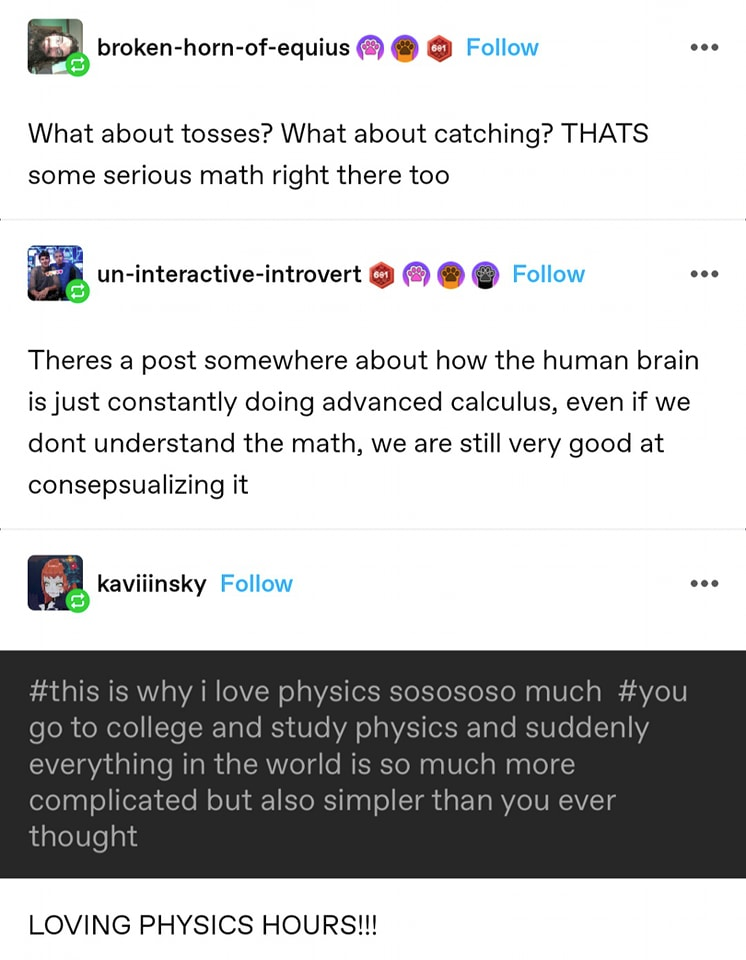

I always imagine it more like neural networks. simply based on a lot of training and experience. As an example think of times when you step onto a non moving escalator. Your mind definitely knows its not moving but you still can’t defeat the trained expectation of jerk.
Sure, but sometimes Thor just says stuff.
Not advanced maths per se; neural networks are amazing! Fuzzy matching based on experience - taken to an incredible level. And, tuneable by internal simulation (imagination).
Don’t be fooled to think computer neural networks is how the brain is structured. Through out history we’ve always compared the brain to the most advanced technology at the time. From clocks, to computers with short and long term memory, and now to neural networks.
That is a good point, though the architecture of computer neutral networks is inspired by how we think the brain works, and if I understand correctly there is some definite similarity in the architecture.
Lots of difference though, still!
I would guess that every statement made is kind of true. It is a clock, a computer and a LLM,…
I would even go as far as LLM is the closest to a functioning brain we can produce from a functional perspective. And even the artificial brains are to complex to understand in detail.
I reckon we can get a lot closer than an LLM in time. For one thing, the mind has particular understanding of interim steps whereas, as I understand it, the LLM has no real concept of meaning between the inputs and the output. Some of this interim is, I think, an important part of how we assess truthfulness of generated ideas before we put them into words.
I experimented with rules like : “Summarize everything of our discussion into one text you can use as memory below your answer.” And “summarize and remove unnecessary info from this text, if contradictions occur act curious to solve them”… simply to mimic a short term memory.
It kind of worked better for problem solving but it ate tokens like crazy and the answers took longer and longer. The current GPT4 models seem to do something similar in the background.
A lot of it is less math and more just approximations using old data, just fitting a complex statistical model neural nets suck ass at math
Most people who’ve been juggling for awhile don’t need too much additional practice to be able to do at least a few blindfolded catches just because of how consistent your throws get after awhile.
The other thing that’s interesting is how pattern recognition in flying things people aren’t generally used to seeing develops. I used to play ultimate, and when people start learning how a frisbee flies they might be susceptible to chasing it down by following along the path of the disc rather than moving directly to where it’s going to end up. This is sometimes called dogging the disc because (many) dogs do the same thing. But then you learn to “read” the disc and you can tell by the flight path and angle of the disc where it’s going to land.
Another one is levelling.
A lot of people can see a picture frame is about 0.5° out of level and their fucking eye twitches until they fix it
Me included
That’s nuts when you think about it
I worked on an industrial robot once, and we parked it such that the middle section of the arm was up above the robot and supposed to be level. I could tell from 50 feet away and a glance that it wasn’t, so we checked. It was off by literally 1 degree.
Degrees are bigger than we think, but also our eyes are incredible instruments.
See, I live in an old apartment. The corners aren’t 90°, the wall a picture is hanging on is convex. When I’m lying in bed and look at the picture it looks like it’s crooked but I used a level several times on it and it’s as straight as can be. It’s driving me insane.
This is when you set it relative to the rest of the unleveled stuff in your view to make it look level.
The tiles in my kitchen were installed slightly rotated so I had to do that with all my shelves
But “level isn’t what you need. If the floor and ceiling aren’t level, it’ll look wrong.
microslippages: some of us just call it what it is … masturbation
If you’re about to walk into a bar with you head, or like the top of a doorpost or smt. You’ll instinctively pull back and avoid the obstacle, inches before it hurts, because your brain notice the hairs on your head moved. That’s why men who have recently gone bald, often have bumps and bruises on their head. My bald colleague told me that for him, that was the hardest thing about going bald.
So by that logic, a boxer who shaves his head will take harder hits!
Or does that fractional reaction cause the brain to shift forward more than it would if they had not reacted? Could that reaction lead to worse brain injuries? Makes me wonder.
You pull away from the object touching your hair, so I don’t think it would lead to worse injuries. I suppose it could set someone up better using fents and jabs.
Maybe I’m understanding wrong but hair don’t have nerves. Is our brain detecting the micro movements of hair follicles inside the skin?
Nerves in the scalp.
When sharpening knives, with practice you can tell when you are done by sliding your fingertips along (not across) the sharpened bevel. It’s possible to feel imperfections measured in micrometers this way.
Worked at a machine shop for a while, it’s funny how the easiest way to gauge surface finish is to run your nail trough it
At one of the places we worked at we would know when the rough cut was deep enough just by feel
We have equipment to measure down to microns, and my students often test how fine details they can feel.
A lot of it is the difference between learning practically and learning theoretically. You don’t have to understand the underlying mechanics in practice to know how to keep getting the same result. Your brain doesn’t have to be doing any math, it just has to have shaken a bottle enough times to have a good comparative basis formed.
Learning to calculate the current remaining volume in a container when observing someone else shake it… that would use all that theoretical knowledge and math.
It’s like knowing how hard you have to throw an egg at a wall for it to break instead of bounce off. You do it 100 times, you just get a good feel for it. Doing all the math, and then trying to learn it practically is barely gonna affect how quickly you learn it in practice. But if you wanted to make a robot that throws it exactly hard enough without wasting any energy, practical knowledge will have almost no value, and theory and math will be incredibly valuable.
This is coming from someone who does indeed have the whole “passive trajectory analysis of every moving object around me” thing. I can’t do crowds or drive at busy times. But, for moving through a minor crowd while reading a book, or pulling into a tight parking space while other cars are moving around near me, it’s very helpful. I have good spatial awareness in general, like parking in my garage with only an inch of clearance on the far side of my car has never been an issue in 14 years so far. Or when doing it with someone else’s borrowed car every now and then too. When I shrug off the difficulty of doing something like that, people seem to be amazed. Otherwise, I would have assumed it was normal, feels normal to me.
deleted by creator






